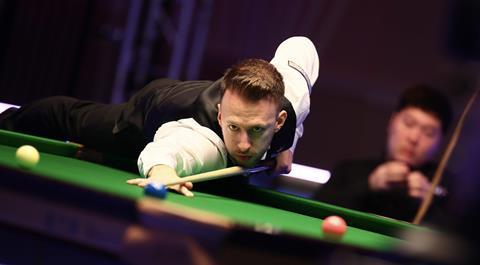Paul Reynolds, SVP of global creative services at MassiveMusic, examines how the sport could improve its audio experience

If you’re looking for a ‘traditional’ sport, you can’t get more on the money than snooker.
Dating back to the 19th century, snooker fans have a powerful respect for, and devotion to, tradition. Which does however mean the sport can be very resistant to change.
Some of the loudest cries of resistance come from Ronnie O’Sullivan, the English snooker player (and certified GOAT). In his 32 years as a professional player, he’s never been one to mince his words. And in his latest headline commentary, he said that if snooker introduced ‘walk-on style music’ in a similar vein to darts, he’d retire.
Any avid fan, however, may be a little confused by this statement, given snooker already uses walk-on music. In O’Sullivan’s case, the tune of choice is ‘Drops of Jupiter’ by Train. So was this comment during the interview a moment of madness or was he directing his umbridge specifically at darts’ use of audio?
Regardless of which pocket you choose, the bottom line is, snooker is struggling to engage new fans in the UK, particularly younger audiences. Could leaning further into the idea of sonic strategy for players or for the sport itself come as music to snooker’s ears?
Chalk it up to experience
Let’s start by looking at the way darts uses walk-on music. Luke Littler took the sporting world by storm earlier this year after becoming the youngest-ever player to compete in and reach the PDC World Darts Championship final. A big part of his ‘act’ was using the walk-on to generate hype and excitement about his play, with fans screaming against a backdrop of Pitbull’s ‘Greenlight’.
And darts isn’t the only sport to embrace walk-on tunes to build hype. Anyone who’s enjoyed the organised chaos of World Wrestling Entertainment (WWE) will testify to the energy and anticipation generated by competitors’ iconic theme tunes.
Take ‘Rest In Peace’, the entrance track of choice for Mark Calaway (better known as The Undertaker). The moment you hear that bell ring at the start of the track, and the lights drop, everyone in the room, and at home, knows what’s happening.
Not only is the track inseparable from The Undertaker’s character; it also delivers on his brand. It has also proven to be a major hit on streaming services, as well as becoming a staple of WWE albums through the years, ensuring it also delivers against the sport’s wider brand.
Licensing a well-known track is one way to connect a sonic identity to personal and wider branding. The other, equally powerful, is creating a tailored piece of music specifically for the sport, as with Irish boxer and Olympic gold medalist Katie Taylor.
Taylor uses an original track by Irish four-piece band Burnchurch called ‘Ringwalk’ when she enters a boxing arena. The piece was specifically crafted for her and uses Irish melodies with an energetic baseline, communicating she’s Irish, proud, classy and most importantly, ready to kick ass.
The theme is designed to match her personality just as much as it is designed to get the audience ready to watch some boxing. These examples show how licensed and composed sonic identities function in sports. But how do these ideas apply specifically to snooker?
Take a cue
Whether it’s darts, boxing or WWE, the thought process behind walk-on music remains the same: to match the hype and energy synonymous with the sport. Snooker doesn’t have this in terms of its gameplay. The fan experience of snooker is traditional, hushed - one where etiquette is paramount and the audience only claps at appropriate times.
Yes, the tracks preferred by snooker players are somewhat upbeat, on paper. But a sonic strategy doesn’t just end with choosing the right audio. It’s also about delivering it in a way that’s authentic and resonates with competitors and fans alike. Case in point, snooker is a game of fine margins, where concentration reigns supreme. The last thing they need is a mile-long march to the table, audience feet thundering, which would almost certainly throw them off their game.
That’s why snooker, more than most sports, has to adhere to best practices, more specifically, knowing when to embrace noise and when silence should reign supreme. Consistency is key. You have to understand the audience and what is appropriate. Otherwise, you risk alienating diehard fans and prospective viewers alike with this dissonance, which could be what O’Sullivan is taking issue with.
The perfect break
So if ‘walk-on’ music isn’t the solution, is there another way snooker can use sound to welcome new audiences? Instead of focusing on each individual player’s sound, it may be wise to take a step back.
What does snooker sound like? And is it time for that sonic strategy to be updated?
We may be living in an age of endless information, yet I challenge anyone reading this to track down snooker’s current theme (spoiler alert - I couldn’t). The best I could find is the BBC’s use of ’The Drag Racer’ by The Doug Wood Band. However, this is a) difficult to verify unless you switch on BBC 2 on a Sunday evening and b) a 50-year-old track, meaning it’s unlikely to ring true with current audiences.
Could the WPBSA (snooker’s governing body) and broadcasters collaborate to update the sport’s sound, similar to work done by FIFA or the Olympics on a regular basis? Broadcasters are quick to adopt these new themes and identities, but snooker feels like it hasn’t really moved.
Pocket glory
The argument around how to bring new audiences into this sport has to do with the way the sport is packaged, communicated and marketed. Music, sound and talent can all be a way to express this.
This isn’t the time for snooker to play a safety shot. The sport’s brand identity is in desperate need of an overhaul. Resistance to change from players and audiences should be expected. So, understanding the context of the sport as well as its legacy, plus how sound plays a part in the sporting journey will be crucial to snooker’s future. May the best sound win.

Paul Reynolds is SVP of global creative services at MassiveMusic





No comments yet